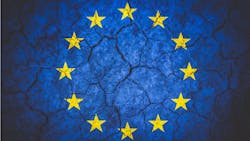Is the New EU Conflict Mineral Regulation Strong Enough?
Download this article in PDF format.
In politically unstable areas of the world, armed groups may use forced labor to mine minerals. They then sell those minerals to fund their activities, for example to buy weapons. Known as “conflict minerals” the tin, tantalum, tungsten and gold (aka, “3TG”) obtained from those mines may find their way into the electronics supply chain.
In January, the European Union’s new law meant to stem the trade of conflict minerals went into effect. Meant to stop conflict minerals and metals from being exported to the EU; prevent global and EU smelters and refiners from using conflict minerals; and stop mine workers from being abused, the law also supports the development of local communities in politically unstable areas of the world.
At its simplest, the new law requires EU companies to ensure they import these minerals and metals from responsible sources only, according to the European Union.
Better Due Diligence Needed
With the first quarter of 2021 now in the rearview mirror, several organizations are reflecting on the effectiveness of the EU’s new conflict mineral legislation. According to the GSM Association (GSMA), which represents mobile operators worldwide, increased demand for 3TG is being fueled by demand for the electronics that use them (e.g., phones, computers, GPS devices, calculators, microwave ovens, televisions, batteries, watches and wires).
With EU importers now required by law to conduct due diligence on their supply chain for 3TG, the world is awakening to the “social and environmental injustice embedded in previously opaque corners of industrial production and a spotlight is shining on global supply chains,” said Katie Tamblin, chief product officer at Achilles Information, in the recent GSMA report, Conflict Minerals 2021: The impact of new EU legislation.
“Due diligence and reporting on conflict minerals will begin to deliver transparency to manufacturers and consumers regarding their role in the promotion or reduction of conflict and forced labor,” Tamblin continued.
But is it Working?
In “2021: a new year marked by new rules against conflict minerals in the EU,” Agathe Smyth writes about how Jan. 1, 2021 marked the culmination of a long civil society campaign as new European legislation on the responsible sourcing of minerals came into force. “Since that date,” Smyth continues, “European Union based companies that import minerals have been officially required to ensure due diligence.” The new regulation is based on legislation and recommendations that have been in existence since 2010 in the U.S., she continues, and member states of the Organization for Economic Cooperation and Development (OECD).
Smyth says that since January, companies importing a certain quantity of 3TG minerals into the EU must now exercise due diligence by proactively verifying and managing their purchases and sales. As a member of the international department of the Belgian National Confederation of Christian Trade Unions, Smyth says that the new EU conflict mineral law is a step in the right direction, but that it’s “too weak” to have a substantial positive impact.
“While the objectives pursued are laudable, some may wonder if the content of the law lives up to the EU’s stated aims, or even if it is really capable of making a lasting difference,” Smyth writes. “Indeed, although the adoption of the legislation has been welcomed by civil society, many organizations still find it too weak.”
For example, the law imposes strict obligations only on “actors at the bottom of the supply chain,” she writes, or those that extract, process and refine raw materials or those who import products at the metal stage.
“Companies which import products beyond this stage, that is to say in the form of a finished product, like the vast majority of European companies, do not have to meet the obligations in the regulation,” she adds. “They are simply encouraged to do so, as is already the case through voluntary rules that have existed for several years but which have so far proved ineffective.”
Best Practices
To help stem the flow of 3TG minerals into the world’s supply chains, the GSMA tells companies to perform more extensive due diligence when minerals originate from and transit through a conflict-affected or high-risk area (CAHRA). And, it says companies that are further down the supply chain (i.e., not buying directly from sources of potential conflict minerals) can use established tools to help them identify the smelters and refiners in the supply chain.
“The most widely adopted tool is the Conflict Minerals Reporting Template (CMRT) form that includes questions to find out what materials are in their supply chain and where they have come from,” GSMA explains. It also helps to understand whether the pinch point (smelters/refiners) have been successfully audited by a due diligence scheme.”
About the Author

Bridget McCrea
Contributing Writer | Supply Chain Connect
Bridget McCrea is a freelance writer who covers business and technology for various publications.







